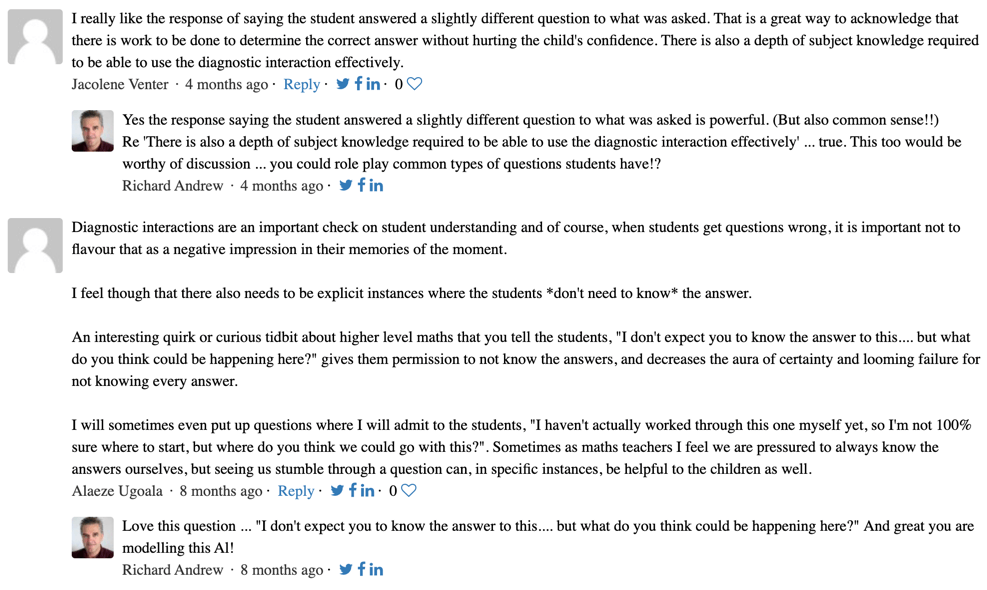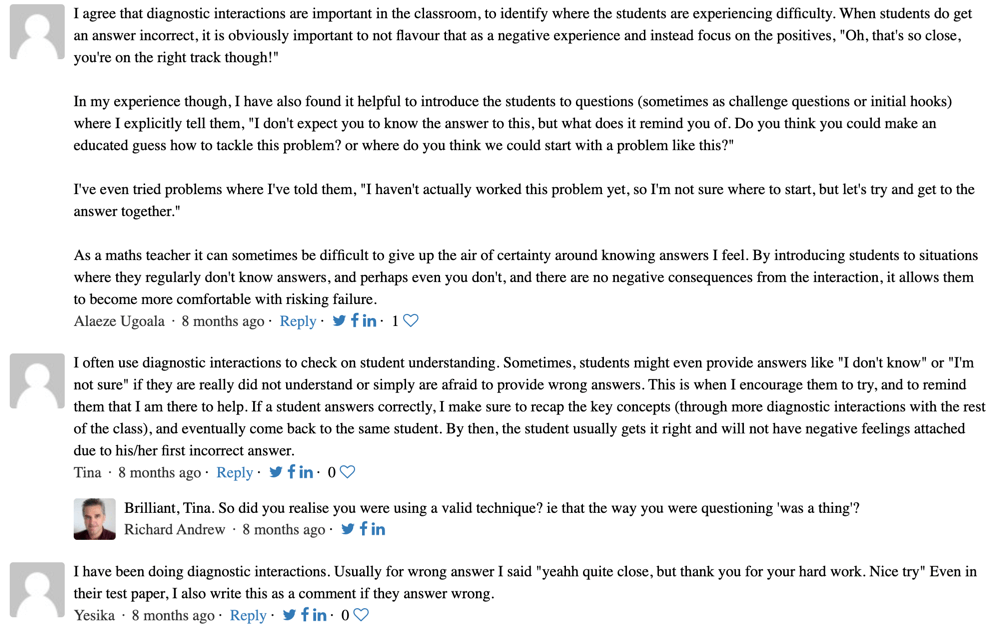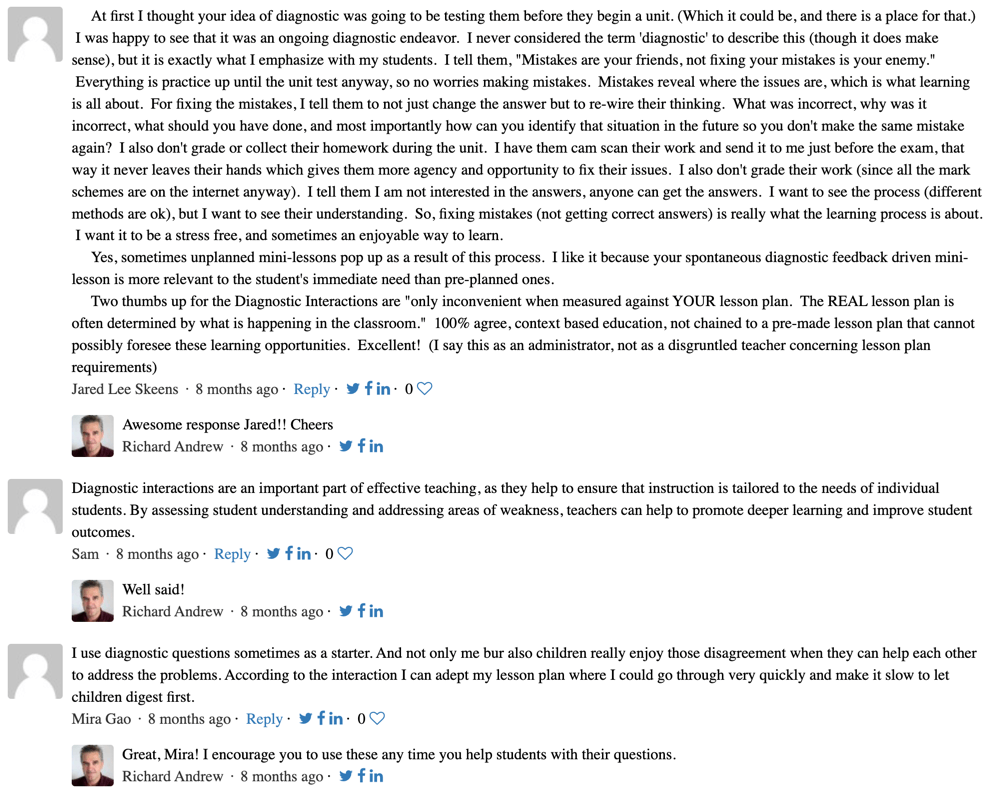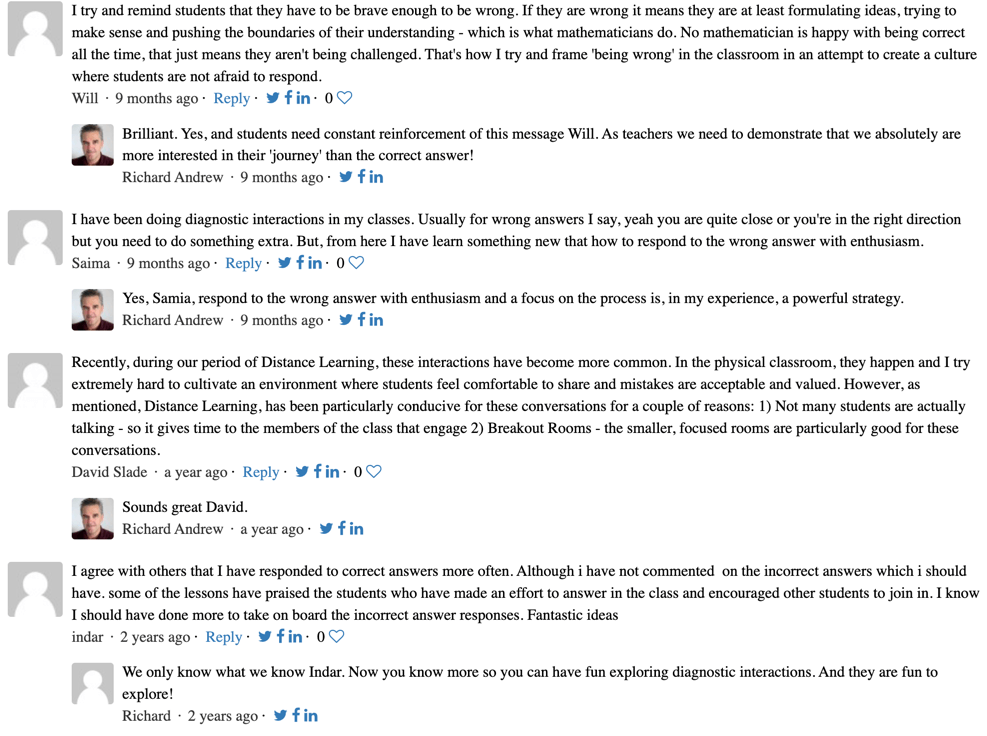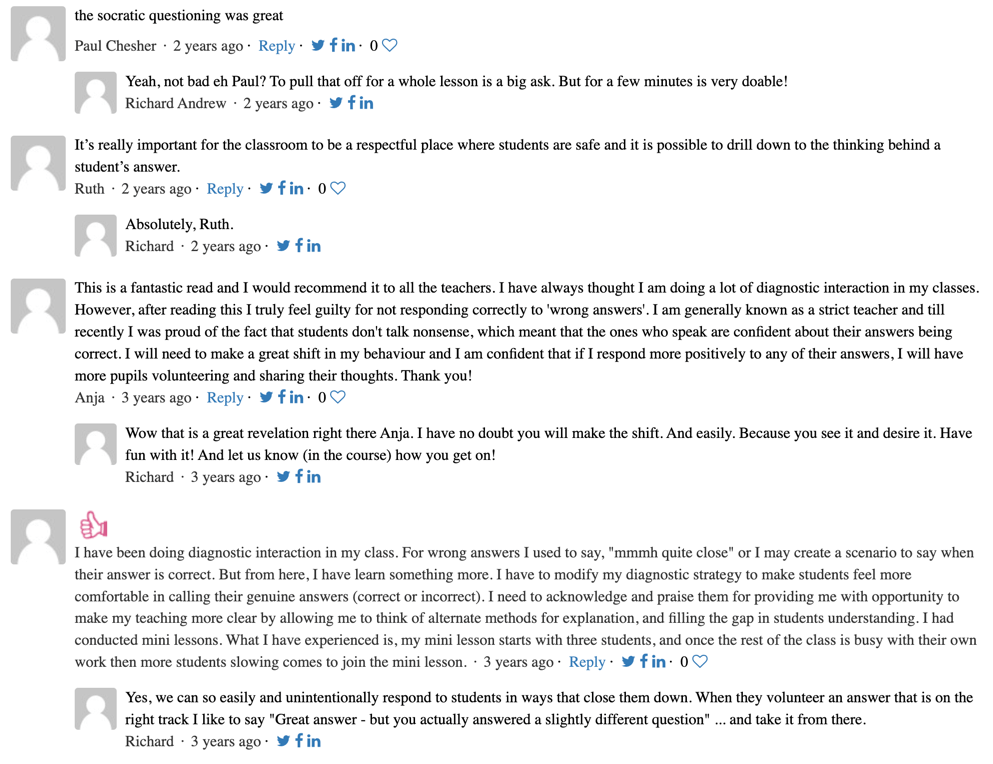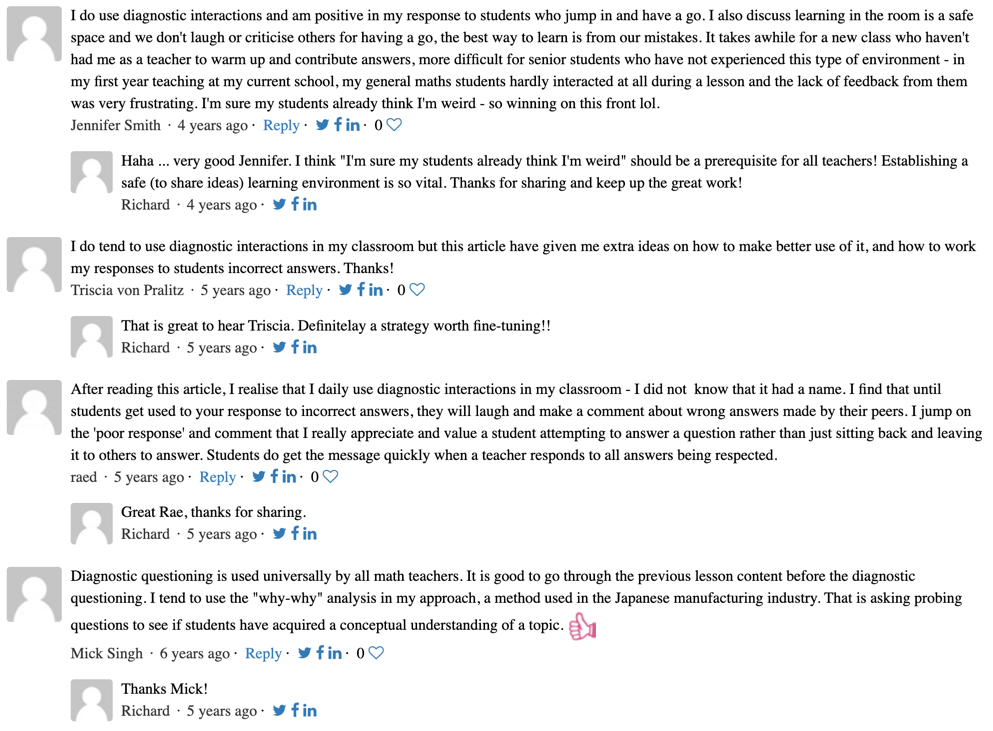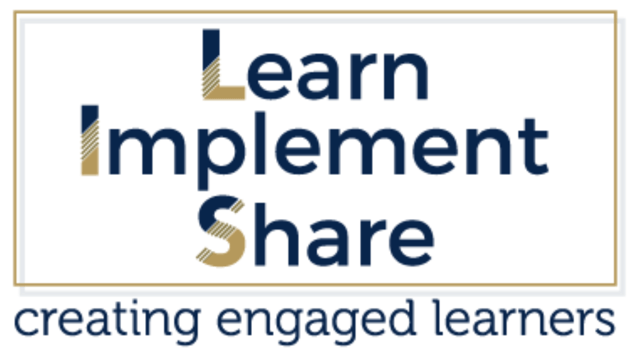Improving Conceptual Understanding In Mathematics With Diagnostic Interactions
It Begins With Praising All Honest Verbal Answers - Even Those That Are Incorrect!
What are diagnostic interactions?
The term diagnostic interactions refers to any teacher-student interactions which allow the teacher to diagnose the gap in understanding of the student. It is a significant technique in helping your students understand the mathematics you are teaching. Diagnostic interactions are useful for all teachers but especially useful for mathematics teachers. If you are a mathematics teacher, you probably engage in diagnostic interactions with your students without even knowing it. By becoming aware of this process, you will improve your ability to interact with your students diagnostically. Diagnostic Interactions are usually verbal. However, they are most effective when accompanied by diagrams or graphical analogies drawn on a whiteboard or a page.
The value of an incorrect answer
Students often give us important, specific information about their current understanding, or lack thereof, through the verbal responses to our questions. This is one of the reasons why it is important to use strategies that elicit verbal responses from students, especially students who find mathematics challenging. I say verbal responses because it is often the verbal responses that give the most accurate picture – or at least an important picture – of a student’s level of understanding.
Prerequisites
One prerequisite of the teacher for diagnostic interactions to occur is to have a comprehensive knowledge of the subject matter, including a clear awareness of the various foundational, mathematical building blocks upon which the particular subject matter rests.
A second prerequisite is that diagnostic interactions require a conducive learning environment. The environment needs to be one in which students:
A second prerequisite is that diagnostic interactions require a conducive learning environment. The environment needs to be one in which students:
- feel safe to volunteer answers, specifically honest, incorrect answers
- have trust in the teacher
- want to learn
The learning process needs to have an Understanding-first focus
|
A final prerequisite is that the teaching and learning process needs to be conceptually–based. A more accurate way of putting this is that the approach needs to be, first and foremost, aimed at having students understand the related concepts BEFORE we expose them to procedures. This is because when we teach maths from a framework of understanding (with an Understanding-first, Procedures-second mindset), we open the door to many more opportunities for diagnostic interactions than when our focus is primarily to teach procedures. (Read 'Why We Need An Understanding-first, Procedures-second Mindset When Teaching Mathematics' for more on this idea.
Cultivating diagnostic interactions with students – some tips:
|
- Explain to the class WHY you want honest answers, including incorrect answers from students. Explain how the process works, and that the student's role is to help you assist them in gaining understanding.
Tips when using diagnostic interactions:
Enthusiasm
It should go without saying that diagnostic interactions are best conducted with a level of enthusiasm. The student should know that you are genuinely happy with their incomplete/incorrect answer. The student should sense you are genuinely pleased to be given an opportunity to help her bridge a gap in her understanding. For example:
- “Brilliant! That’s not quite the correct answer. But you are on the right track. I’m happy because you have just given me a clue to something you don’t quite understand - and this is a common misunderstanding. Hands up … who else isn’t quite sure about … “
Avoid making the student wrong
Most students are reluctant to voice answers if they are not confident that their answer is correct. Therefore, avoid at all costs the “No, that’s wrong” response because that response only serves to reinforce the student’s conclusion “I should have kept my mouth shut!” Remember that the key point here is to understand that diagnostic interactions require honest, incorrect answers from students. Therefore we need to use techniques to maximise honest, incorrect answers. Responses like the one below will help our cause:
“Thanks for that Caleb, you answered a slightly different question to the one I asked, but well done because you have helped me see what you need to understand. Who else is uncertain with this question? OK, stay with me as I show you something …”
... and then continue with the diagnostic interaction to bridge the gap using the whiteboard, some other equipment or whatever is required.
Enrol other students into the diagnostic interaction
In almost every situation an opportunity for a diagnostic interaction provided by a student’s incorrect answer will be relevant to other students in the class. It is important, therefore, to ascertain who these other students are because:
- It helps those students to tune in, and
- it helps the original student – the one who volunteered the incorrect answer – to realise “Wow, I’m not alone in this.”
- “Who else would like to see this explained? Four hands up. So this applies to at least five of you. Excellent!”
An opportunity for a mini-lesson
If in the above scenario, you predict the diagnostic interaction will be brief then you may choose to run it with the whole class. Alternatively, and especially if the interaction is going to take five minutes or so, simply run a mini lesson. The mini-lesson can be conducted with the students remaining in their seats. For example:
“Who else would like to see this explained? Four hands up. So this applies to at least five of you. Excellent! Those with hands up … keep your eyes on me. I’ll run a mini-lesson. The rest of you – if you know that you know this aspect – then work on quietly.”
They may think you are weird!
When you respond to a student’s incorrect answer with enthusiasm – enthusiasm for an (honest) incorrect answer – your student is likely to think “There’s Mr A being weird again!” This is because it makes little logical sense to them for you to be enthusiastic over their mistake. They’ve had years of “NO … WRONG ANSWER” and now here you are saying “ wrong answer … fantastic!” But, of course, to be on the receiving end of student accusations that their teacher is acting (positively) weird is something every math teacher ought to strive for!
A couple of extra tips
- Using Socratic questioning - this is a great read!
- Exploring various conceptual approaches will assist you as you work towards bridging the gap in understanding through a diagnostic interaction.
Diagnostic Interactions can be inconvenient!
You will often spot an opportunity for a diagnostic interaction when working through an activity with the entire class. A student will respond to a question in a way that informs you of a gap in their understanding, a gap that is tangential to your immediate message. In other words, diagnostic interactions are often not part of the planned lesson and can therefore be viewed as inconvenient. Avoid at all costs showing signs of frustration due to this (perceived) inconvenience. Remember a diagnostic interaction is only inconvenient when measured against YOUR lesson plan. The REAL lesson plan is often determined by what is happening in the room!
Responding to tangential diagnostic interactions
In situations where the momentum of a whole class activity needs to be maintained, acknowledge the importance of the student’s response and state that you will respond to it later in the lesson. Obviously, we cannot pursue every opportunity for a diagnostic interaction. It will be up to you to make judgement calls. A question worth asking yourself is “How different would my teaching look if I were to pursue, on average, one quality diagnostic interaction per lesson? Would this benefit my students?”
A learning journey to support you in cultivating a conducive learning environment in your classroom
Cultivating an engaged learning environment is ultimately what the teaching and learning process is all about. It is through a conducive learning environment that opportunities for diagnostic interactions occur. Teachers interested in fostering an improved culture of learning amongst their students and in being supported in creating more and better learning opportunities are recommended to enrol in the 6-month comprehensive online PD, 'Agency - Empowering Your Maths Students'.
Subscribe to receive free tutorials, information and to stay in touch
Comments anyone?
Do you use diagnostic interactions? Are you tempted to use them more? We'd love your thoughts below.
NOTE: Create a Hyvor account before commenting so you are notified of replies to your comment (if you don't you'll be anonymous) ... OR ... state your name at the start of your comment. Thanks.
Do you use diagnostic interactions? Are you tempted to use them more? We'd love your thoughts below.
NOTE: Create a Hyvor account before commenting so you are notified of replies to your comment (if you don't you'll be anonymous) ... OR ... state your name at the start of your comment. Thanks.




